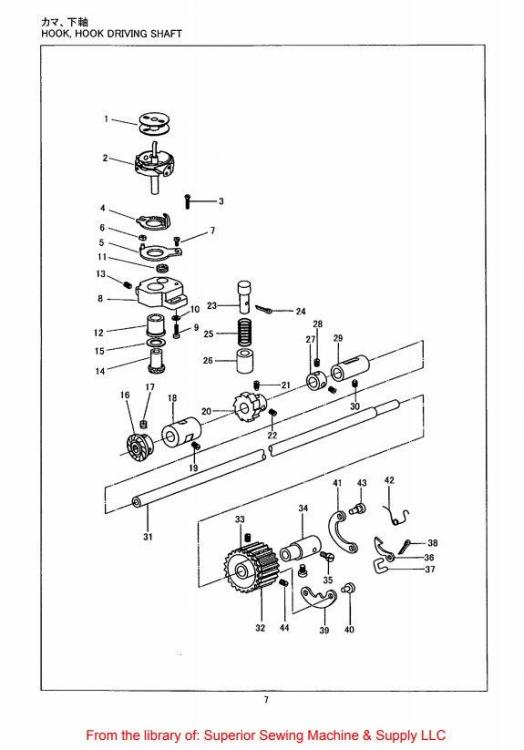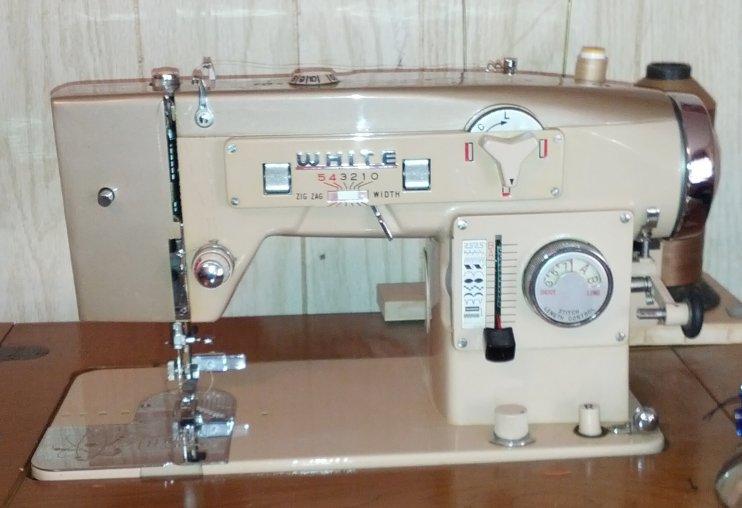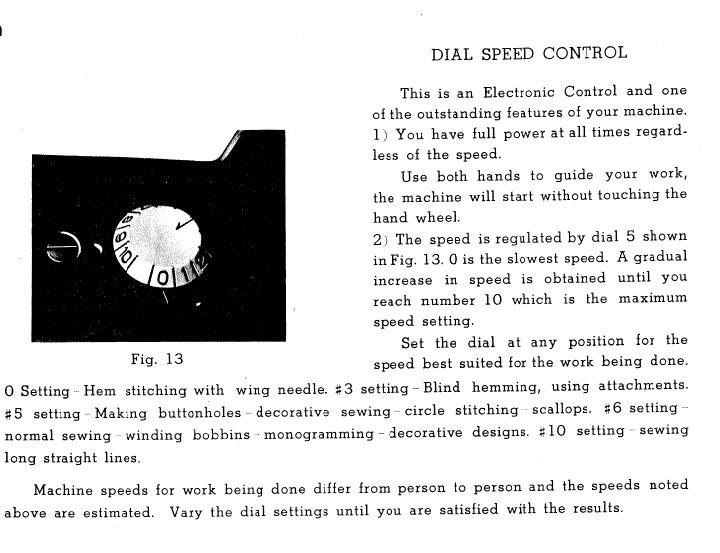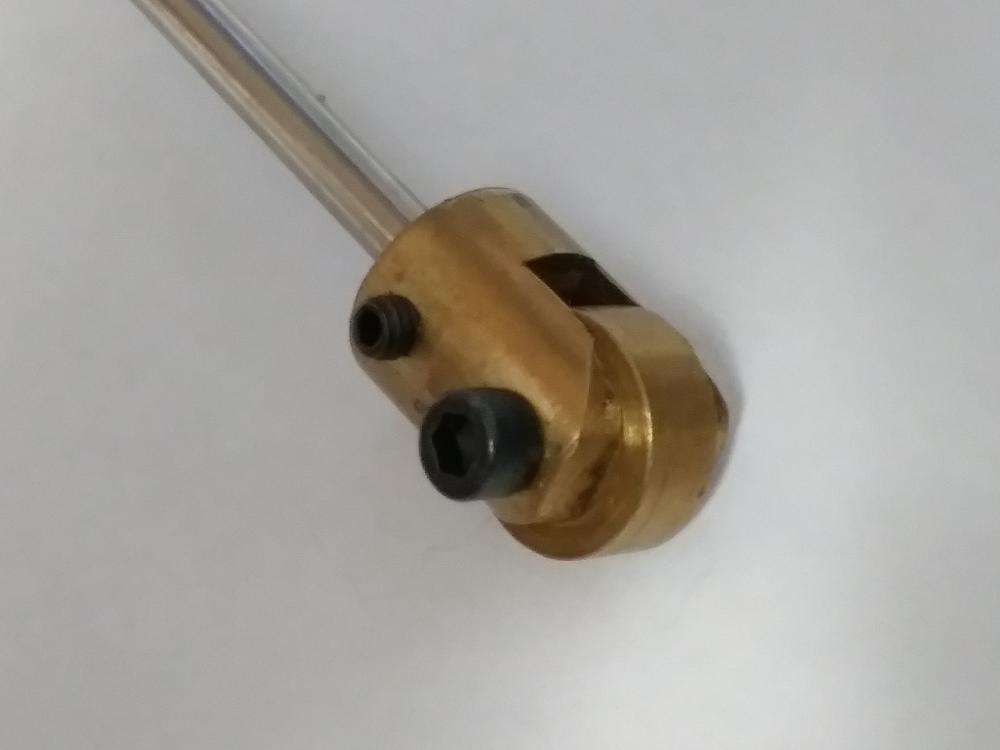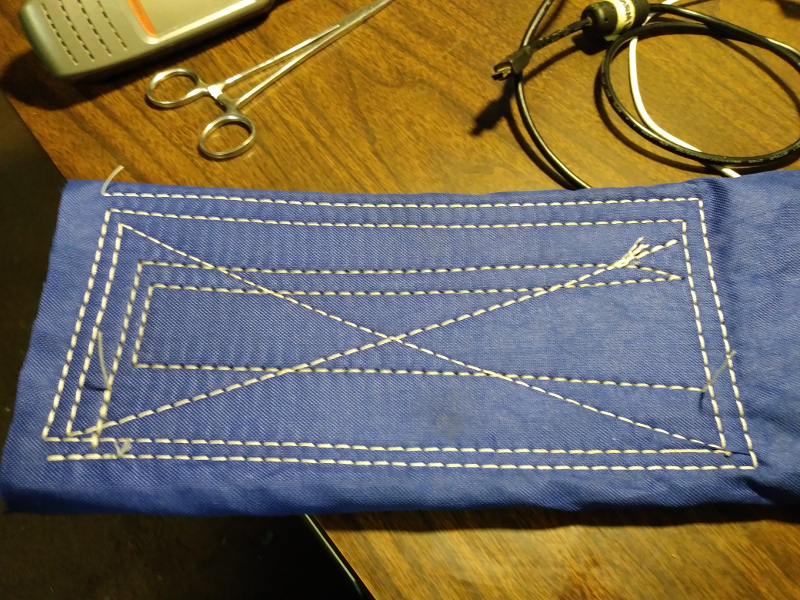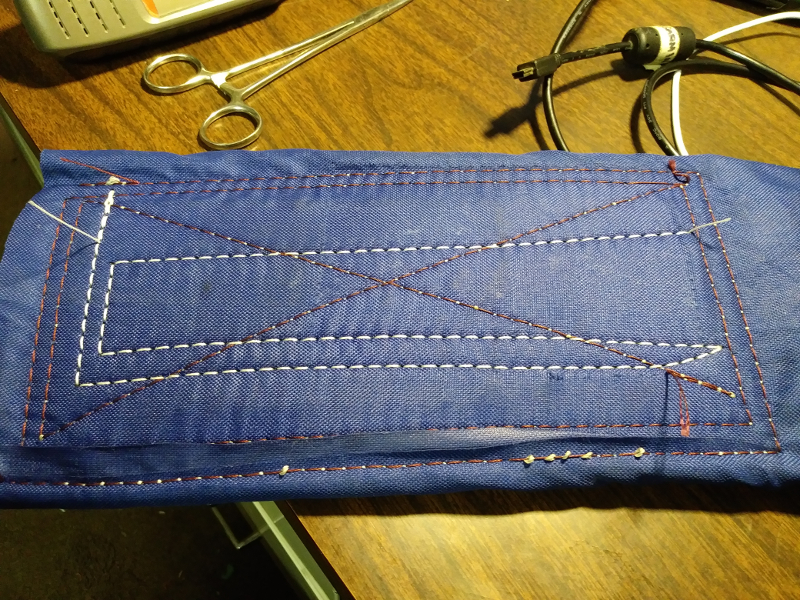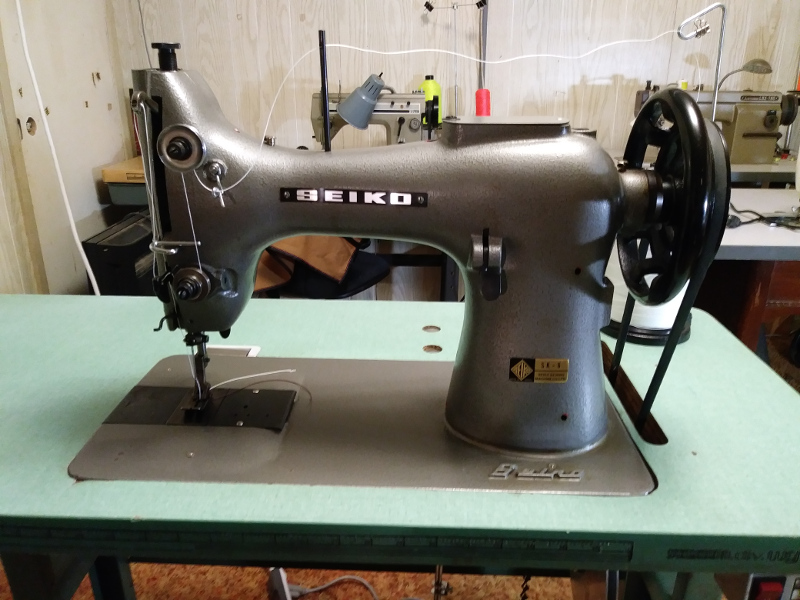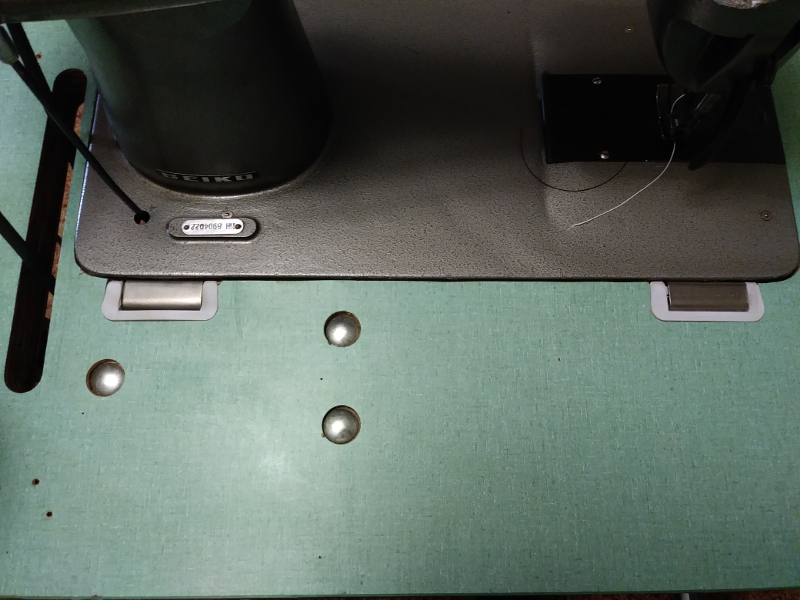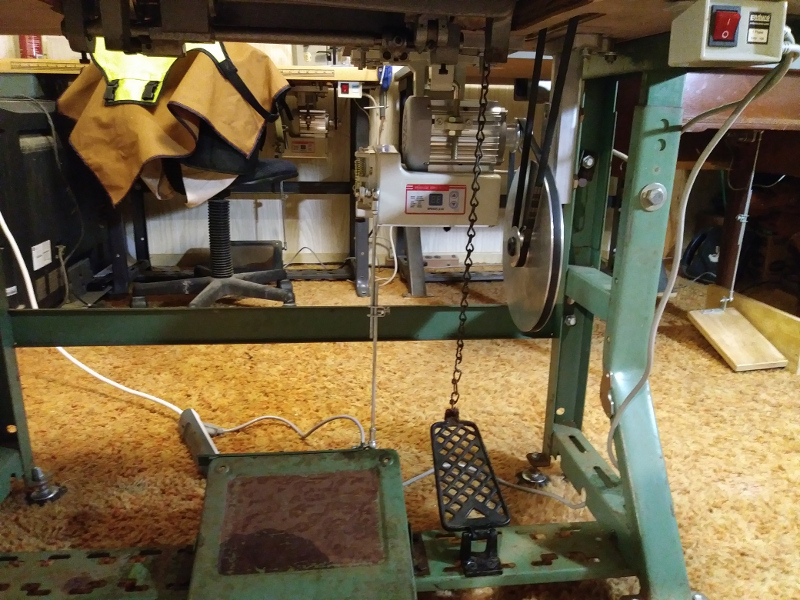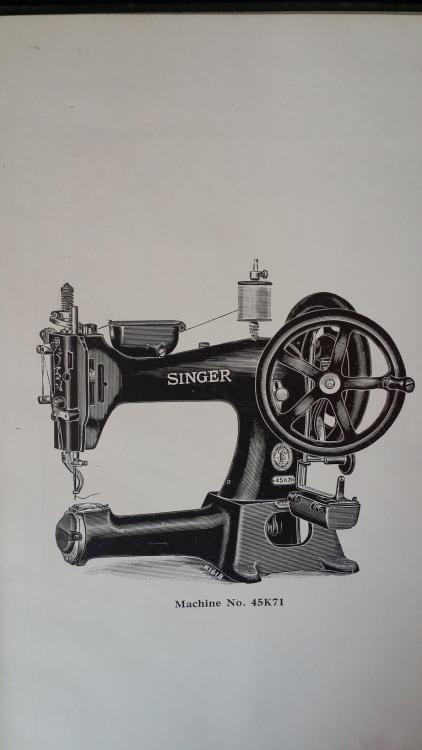-
Posts
391 -
Joined
-
Last visited
Content Type
Profiles
Forums
Events
Blogs
Gallery
Everything posted by SARK9
-
-
I've had 3 LU-563's...none of them have ever had an anti-backlash spring in the bobbin basket. Frankly, I didn't know such a thing existed, but that certainly means nothing. Most of the work product you will encounter on a site such as this is quite often produced by machines using *speed reducers* ; The anti-backlash spring is more a fixture of balls-to-the-walls garment or other fabric trades, where you run the machines at speeds close to the maximum your 3450 rpm clutch motor is capable of, punctuated with ABRUPT stops at the end of a stitch line. The anti-backlash spring helps overcome the spinning inertia of the rapidly rotating bobbin when the thread demand STOPS INSTANTLY, otherwise you get a mess of a bird's nest reminiscent of what you'd see with a bad cast from an old-school bait casting fishing reel. That flat blue spring is very often furnished with the bobbin cases of many horizontal axis machines, but I've never heard of one for a 563, and never seen one called out in a Juki LU-563 parts list. Unless you are doing long runs like production shop marine applications can require, I'd guess you will never miss it in your Juki. BTW, I'd like to see a picture of the model badge on your Juki...I'm not familiar with a 563L subclass. -DC
-

Trying to identify this clone sewing machine
SARK9 replied to kayw's topic in Leather Sewing Machines
This is a generic clone sold under several "badges" and quality levels. Sort of a Singer 45K inspired type of machine. The GA5-1R has reverse. https://www.aliexpress.com/item/GA5-1-thick-sewing-machine/2018367505.html Google images has a zillion to compare. -DC -
Google "Techsew 2800 standard sewing set". -DC
-
Those are "pre-wound" bobbins which are commercially produced to eliminate the metal bobbins in industrial machines. The "style" for a 29-4 is a (number) 19, the small bobbin patcher size, whereas the "large bobbin" version is a style (letter) I as far as I can tell. I have no idea who may still be offering them. -DC
-

SEIKO - What kind of sewing machine is this?
SARK9 replied to Seom's topic in Leather Sewing Machines
Nakajima also made this machine as a "DD-N73" and branded it Yakumo as well. I would suggest that anything branded by Nakajima or Seiko will be very good quality. There are hints that this machine was their take on the Singer 45K. -DC- 29 replies
-
- seiko
- sewingmachine
-
(and 2 more)
Tagged with:
-

PFAFF 145 needle adjustment in feed dog
SARK9 replied to DanishMan's topic in Leather Sewing Machines
Strongly suggests bent needle bar to me. -DC -
The tag does say 153....but I have no explanation for it. The machine certainly LOOKS like a model previous to the 111W15(X) models. The common wisdom says they changed the stitch length adjustment from the dial on the handwheel to the stop button on the bed and a stitch length scale you viewed through a hole in the column after the 111W152 model (I have a W152 and it is fitted out as described), and also added a safety clutch to protect the hook, also with its own button in line with the stitch adjustment stop button. You can see the pretty prominent pair of buttons on the bed in the picture posted. The single button you refer to may be an oiler ball zerk, in the depressed area behind the bobbin cover plate. It really only matters if you are trying to find some of the parts for the earlier type machine in a W153 manual. I know several here own examples of the earlier 111W machines and can perhaps explain when the W153 runs actually began. -DC
-
Are you sure this isn't a 111W103? It has the older stitch adjustment knob on the handwheel and no buttons protruding through the bed like the 111W15(x) series machines have. -DC
-

Juki dnu 1541s bent bobbin winding tention
SARK9 replied to rhdiv's topic in Leather Sewing Machines
The easiest way to straighten that bend is to remove it from the top cover, then put the bent portion between the jaws of a good vise and press the bend out. Hammering may be a bit too violent for the scale of the part. -DC -
I'm not a Pfaff guy so I'm not sure how much of this applies to the old casting machines- my charts show: H3 = Top feed lift 5.5mm, 11mm foot lift 734/ = Gathering mechanism (top drive) 921/ = optical top feed variation indicator 6/01 = standard parts for plain sewing ops B = For medium materials S = Fabric -DC
-
The noises it makes suggest it IS spinning when you activate the pedal....if the shaft is not free-spinning inside the pulley (broken/missing key) or loose set screw/nut/other fastener, then its possible the output shaft itself could be broken at a point past the brushes. Stranger things have happened. These old-school brush motors with a max-rpm limit dial have been used in some form on sewing machines since at least the 70's....one example is seen here on the old White model 970 from way back. -DC
-
Heavens no. That is the manufacturer's description of the MAXIMUM mechanical foot lift available, and like any other machine, its designed to unload the thread tension a good bit before that height. Technically it might sew, but it won't make viable stitches. My SK-6 lifts almost 16mm by pedal, but only will sew about 11.5mm. -DC
-
The model number certainly suggests some Seiko/Consew heritage (AKA the Seiko CW-8B)...and at the least, that *B* in their models usually indicated the larger "M" style bobbins. The Seiko specs for the CW series show a max foot lift (by pedal) of 14mm, and a max stitch length of 5mm. -DC
-

Is there standard for twin needle machines?
SARK9 replied to katit's topic in Leather Sewing Machines
The feet on this machine seem to be set up for applying tape to a seam....has the tape slot *made in*, along with a centering guide on the inner foot. The gauge set for your desired needle spacing will have a new needle plate with the feed dogs and needle holder. If you are making *gear* with the frequent 3D internal shapes, this could be worth hanging on to. The needle system is a good thing too, loads of choices, brands, sizes. How does the stitch adjuster on this one look? Lots of machines that were used in factories for a dedicated operation had some features (like the stitch length) disabled so they couldn't be tampered with or adjusted by the operator. Could be trivial to reset to original. -DC -
Also echoed in a very helpful suggestion from Gregg at Keystone Sewing, Posted February 14, 2017 in https://leatherworker.net/forum/topic/74275-the-clutch-motor/ "[...] Also...if the clutch lining (cork) is worn, or glazed over, this could be an issue, as well. Taking off the end bell of the motor to expose the cork, you can hit it with some light sandpaper to break off the glaze, and then put a thin layer of axle grease (we use Castrol multipurpose wheel bearing grease here). These two things may help go a very long way to getting the motor under control. Again, we like to sell servo motors as replacements, but people have been successfully doing may things on machines like these with standard clutch motors for many many decades without too much issue." ------- My take on the whole issue is that this judicious application of grease is a more expedient path to entry-level success than several years of self-flagellation and dogged determination will bring. Discarding a clutch motor in favor of a "servo" type motor is a faster path yet. -DC
-

Singer 111W153 & table resto project
SARK9 replied to Sugarkryptonite's topic in Leather Sewing Machines
-
Seiko SK-6 Minor tune up and stitching test- I bought a selection of needles and needle types, plus some heavy thread to get the machine adjusted and confirm it would function reliably at the upper end of its capacity. First go was with a #24 RP needle and T270 thread top/T210 bottom. Material sewn was a rectangle of 3/8" very firm "stall mat rubber" wrapped in about 10 layers of 1000D Cordura. Total thickness measured 0.456" or about 11.6mm. This seems to be about the max practical foot lift before the main tension discs unload. I'll look around for any tips or tricks to increase the machine's lift capacity a slight bit more. The machine did a good job on the upper stitch, but needed more upper tension as the knots were just visible on the underside. Of more concern was about 4 skipped stitches right at the beginning of the test. I looked at the hook/needle proximity and the needle eye seemed quite a bit too close to the hook point....checking the needle bar showed a small difference in patina around the clamp, suggesting the needle bar had slipped up at some point and needed to be reset and tightened. Without a service guide I just watched the loop form and lowered the bar to what I would consider a typical relationship to the hook point. I increased the upper tension about a full twist. Hand cycling detected no hard bits making contact. I switched over to some T-350 top thread/T270 bobbin thread and a #26 needle. The machine seemed to stitch quite well and feed pretty uniformly with the heavier thread and needle after the adjustments. The machine is making a VERY nice tight stitch now. I DO miss the reverse levers I've become addicted to but this gives me an excuse to do the "flip it 180" lock stitch technique. Top side stitching left picture, bottom on right. You can see the second test with the 350/270 thread on the bottom since the 277 bobbin thread was white on the 2nd run: -DC
- 9 replies
-
- seiko sk*
- singer 132k*
-
(and 2 more)
Tagged with:
-
Dikman quoth: "The only thing that I can see wrong with the table is the colour!" The std. 20" wide table top is a bit too narrow for a heavy machine with a bed width of around 10"....it crowds things, particularly on the underside, plus who needs an excuse to make a new top? @DFH--> Nicklesville is around an hour away, pretty much right down the road. @DonInReno Did you see the "official specs" from the Seiko manual I copied? Needle DDX1 #18 to #29, Seriously? My charts show that needle size is good for a ridiculous sized thread, though the thread specs show it tops out with #5/T-350. Whoa. I'm not exactly sure what converts to the #00 size....The machine came with some diamond point needles, and I've got some fabric needles on the way. I'll have to see it work with T-70 to believe that one. @Constabulary Good info on the presser feet, I only have the one that came with it. I have a sort of universal standalone bobbin winder made up with opposed cones on the shaft that handles anything from my 29K bobbins thru this machine's monsters...the drip pan would be nice, but dang! From Germany? Sounds like a bunch of postage stamps would give their life for that one! If you still have a 132K with a head rest peg, I'd love to see a picture of it tilted back to show how the "factory" intended for the machine head to be supported. -DC
- 9 replies
-
- seiko sk*
- singer 132k*
-
(and 2 more)
Tagged with:
-
I picked up one of these next-level upholstery type machines over the holidays....just in case I needed a bigger hole punched in something! The machine was sitting in a rather crude sawed hole in a too-narrow "standard" industrial table....the first order of business was to clean out the inletting to allow clearance for the machine to tilt back, and rout the table top for the usual hinges. Next, the motor that came with it was physically too large to allow the foot-lift chain's connection to function....I swapped it with one of my older Consew CS-1000's (with the optical gradient controller), then relocated the pedals to suit. I popped in a spare 9-1/2" X 2" reducer pulley, which with the nice large handwheel pulley and a 2" motor pulley should yield about a 7:1 ratio. Slow it is! The backside of the machine is a pretty curvy landscape....I'd appreciate some input from one of the folks here with a Singer 132K* or similar for advice on where to locate the head rest peg in the table, or what part of the machine head seems to be the best support area for this sorta heavy item to rest on. I'll make up a new table for it after it warms up enough to paint and use contact cement. -DC
- 9 replies
-
- seiko sk*
- singer 132k*
-
(and 2 more)
Tagged with:
-
A practical approach you might consider is to get the new CB3200 or similar with warranty and dealer support, then add a flatbed attachment if needed. This gets you sewing with the maximum versatility right off the bat, using a machine that has a large current following and plenty of experienced advisers for your applications. You could take the money you save on the price difference between the 3200 and a new 1508 class machine and look for a serious deal on one of the very popular upholstery-type walking foot flatbed machines, such as the Juki LU-563, the Consew 206RB*, Seiko STH-8BL, or literally dozens of similar good quality models that frequently show up in usable condition at attractive prices. Its not impossible that the dealer you approach for your 3200-type machine would make you a package deal to include an older flatbed candidate, and he will know the how to navigate the huge range of models available. Several of these older machines such as the Juki LU-563 can often use T-210 thread, or be modified to run it. -DC
-
Looks like a clone of a Mitsubishi DU-105, also cloned by Chandler as a C-75. Here's a video demo of something similar- -DC
-
Has someone out there actually SEEN a 45K71 with the side handwheel? I'm curious about the mechanics involved, as the photo seems to suggest a picture of that handwheel sort of floating in space... ?? It must use an external bevel gear that just engages the rear mounted handwheel.... -DC
-
Like he said. The lack of bonding on most Kevlar threads is a bit of a hassle when threading your needle.... First, its often very difficult to cut cleanly and tends to *puff out* with nearly invisible straggler filaments when the cut end is even slightly touched. Miss the eye on your first stab and you usually have to re-trim the frayed end. Also, you won't be melting or burning the ends of your thread tails. Color selection is pretty skimpy, and the colorfastness is a bit of a gamble with different brands. Mostly you need to find something to like about its natural yellowish color. I have used a little on nearly every machine I have at one time or another, from T-45 to T-210, and other than the hassle threading the needles, its never seemed to be that fussy to sew with any of my hooks set normally, but then, I don't really sew production quantities, just specific sporadic needs. You probably don't want to wrap a big birds nest all around and under your hook.... -DC
-
The Thread Exchange has info on most of this stuff- https://www.thethreadexchange.com/downloads/the-thread-exchange_Kevlar_guide.pdf https://www.thethreadexchange.com/miva/merchant.mvc?Screen=CTGY&Store_Code=TTE&Category_Code=ptfe-fiberglass-Thread-Information Some of my research for my own applications indicates that Kevlar materials are not particularly suitable for prolonged UV exposure, and there are cases where its own relative strength is reported to be a disadvantage, as it is so much more durable than the materials it interfaces with that it can "saw" its way thru joined items in certain conditions of load stress and movement. Your designs need to take several factors into account when you wish to take full advantage of the remarkable strength of these aramid materials. -DC



